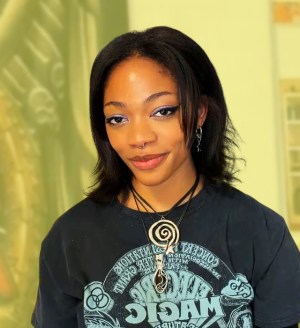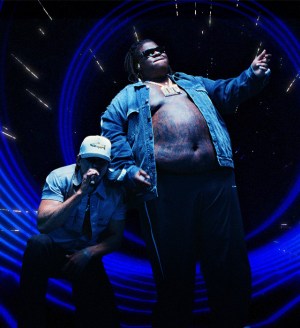Music + Culture
SHOWS
Covers Books
EVENTS
FEATURED
BRANDS
TRAVEL,
DRINKS & EATS
DRINKS & EATS
Latest
Uproxx’s Joypocalypse Explains How The Ramones’ Cohesiveness Made Them Legends
The Ramones, as the name suggests, was a band full of musicians with the last name Ramone... except that's not quite true, as all the group members just adopted stage names that only made them seem like family. (Not even leader Joey Ramone used his real name, which was Jeffrey Hyman). They had the natural chemistry of a family, though: For two decades, the band released new albums nearly every year and toured just about nonstop. As Uproxx's Joypocalypse, it was their cohesiveness that made the whole thing work. https://www.instagram.com/p/DTBApn-kbMa/ She says: "Getting all your band members to adopt the…
Uproxx’s Baylee Lefton Shines A Light On Women In ’90s Hip-Hop With Her Latest Playlist
Keeping up with music news and resources like Spotify's giant and regularly updated New Music Friday playlist are great ways to keep your listening habits from getting stale. Sometimes, though, you need a deeper dive. That's where Uproxx's Baylee Lefton comes in as she routinely offers quick-hit lists of songs you need to add into your rotation this week. She just delivered a fresh mix and it honors the women of hip-hop in the 1990s. https://www.instagram.com/p/DS77rr2AaaR/ The mix kicks off with "Afro Puffs" by The Lady Of Rage, followed by Lin Que's "This Is It," Polyrhythm Addicts' "Take Me Home"…
The Kid Laroi Rings In The New Year With The Reflective Single ‘Back When You Were Mine’
It usually takes a minute for the gears of the music industry to start spinning again after it goes mostly dormant during the year-end holiday season. The Kid Laroi is kicking things off early, though: He has a new album, Before I Forget, out next week. He also previewed it today (January 2) with "Back When You Were Mine." It's a tender and emotional single that sees him reflecting, "Caught up in the thought of us / And the way you used to feel with me / Tell them anything you like / But the truth, that's a whole 'nother…
Juan Duque Is Building Colombia’s Next Global Pop Moment
Following a breakthrough year with the smash hit "Solcito," the future is looking even brighter for Juan Duque. The Colombian heartthrob has positioned himself as the next global pop star with his soulful and sentimental songs that transcend genre. At the same time, Duque is showing a different side to his country with his roots in the small town of Marinilla. His humble beginnings are the foundation on which he's building his path towards superstardom. "I owe being a hard worker, responsible, and not being afraid of anything to growing up in Marinilla," Duque says. "The people here are go-getters.…
Ranking The 100 Best Bourbons Of 2025
The end of the year is here, and the results are in! These are the top 100 bourbons of 2025. This year, the whiskey industry faced existential challenges, with uncertainty in international trade and evolving consumer trends standing out as obstacles. Whiskey has been on an unprecedented ascent for the better part of a decade, and so it's not surprising to see a course correction as we enter the second half of the 2020s. That said, savvy producers know that obstacles are only opportunities by another name, and those challenges have led brands to become increasingly creative in meeting consumers…
Elliott Wilson’s Best Of Hip-Hop 2025
It was the best of hip-hop times. It was the worst of hip-hop times. Ha! 2025 was a rollercoaster of rap music’s highs and lows. The duality was so real. I can’t recall a year with such a wide array of formidable full-length albums. But like I cried the blues on The Bigger Picture about more than a few times — there was a shortage of slaps. Has the hip-hop industry forgotten how to make hit songs? I know most dismissed the reports about hip-hop’s lack of presence on the charts, but that’s exactly the kind of thing that ruffles…
The Best Vinyl Releases Of December 2025
Anybody who thought the vinyl resurgence was just a fad was mistaken: The industry has experienced a legitimate revival. As a result, music fans are interested in physical media in ways they may not have if the decades-old medium hasn't made a comeback. That doesn't mean everybody is listening to just their parents' old music, though. That's part of it, sure, thanks to rereleases that present classic albums in new ways. A vital part of the renewed vinyl wave, though, is new projects being released as records, of which there are plenty. Whatever you might be into, each month brings…
Ethel Cain Unexpectedly Drops Some ‘Willoughby Tucker, I’ll Always Love You’ Demos On Soundcloud
Ethel Cain had a great year with the release of her latest album, Willoughby Tucker, I'll Always Love You. Before ringing in 2026, she decided to give fans one more gift this year: a handful of demos from the making of the project, which she shared on Soundcloud yesterday (December 29). Announcing the tracks on Instagram, Cain wrote, "uploaded some demos from willoughby tucker onto my soundcloud. thank u all for the love on perverts and my little blood stained blonde this year. until whatever's next.... goodnight." The individual song uploads on Soundcloud come with brief notes. Cain writes of…
The Most Overlooked Indie Albums Of 2025
Tough as it is to define "emo" in 2025, "overlooked" feels like a much bigger challenge. First off, "overlooked" to whom? On the one hand, the music critic community is more expansive than ever and no matter how seemingly obscure a genre or geographical region felt even two years ago, it's probably being covered somewhere in depth and detail. If you know where to look, that is. On the other hand, that same fractionation somehow amplifies the consensus by the time year-end lists start to publish (at this rate, by mid-November in 2026). As everyone tends to their niche, a…
Cardi B Will Spend January Rehearsing ’10 To 12 Hours A Day’ For Her Long-Awaited 2026 Tour
A couple weeks ago, Cardi B shared that's she's been on the treadmill preparing for her upcoming tour, which launches in February 2026. Now she has revealed just what her workload will look like in the coming weeks. In a video shared today (December 29), Cardi starts with a message for some of her more combative followers, who she says have "been dragging me for three or four days." She notes, "Y'all been a little bit too mean," before continuing: "2026 is in a couple of days. I have so much work to do once January starts that is stressing…
Uproxx’s Baylee Lefton Highlights Amazing Guitar Moments With Her Latest Playlist
Keeping up with music news and resources like Spotify's giant and regularly updated New Music Friday playlist are great ways to keep your listening habits from getting stale. Sometimes, though, you need a deeper dive. That's where Uproxx's Baylee Lefton comes in as she routinely offers quick-hit lists of songs you need to add into your rotation this week. She just delivered a fresh mix and it features tracks that have amazing guitar moments. https://www.instagram.com/p/DSvZJS0EiUg/ The set kicks off with a live rendition of Gary Clark Jr.'s "Our Love," of which Baylee notes, "I saw Gary Clark Jr. in concert…
Selena Gomez, Benny Blanco, And Taylor Swift Had Some Of 2025’s Most-Liked Instagram Posts
2025 was full of huge music stories: the Oasis reunion, AI music, Kendrick Lamar's Super Bowl Halftime Show, and so on. As far as what was popping off on social media, that falls more in the pop sphere. Per data collected on Wikipedia and accurate as of December 24, the most-like Instagram post from an American musician shared in 2025 comes from Taylor Swift, as her and Travis Kelce's engagement announcement has over 37.6 million likes. Also on the list are photos from Selena Gomez and Benny Blanco's wedding, which garnered 24.6 million likes. The year's most-liked post overall comes…
Uproxx’s Joypocalypse Declares Viagra Boys Are Post-Punk At Its Most Fun
When hearing their band name, it's immediately clear that Viagra Boys are here to have a good time. They offered further evidence of that earlier this year with the title of their 2025 album, the more email-spam-filter-friendly Viagr Aboys. Silliness aside, though, Viagra Boys are also just pumping out the jams in a strong way, delivering a handful of well-received albums since their 2018 debut Street Worms. As Uproxx's Joypocalypse puts it in a new video, post-punk can be fun and humorous, and Viagra Boys do a great job at demonstrating this by not taking themselves too seriously. https://www.instagram.com/p/DSvcj6AEit8/ She…
The Best Emo Albums Of 2025
This year's Best Friends Forever festival featured a reunited Texas Is The Reason and Knapsack, Burning Airlines, Rival Schools, Jawbreaker, Mineral's final show, and a Jimmy Eat World headlining set that featured as many songs from Static Prevails as Bleed American; Even then, "Sweetness" and "The Middle" were tacked on last as a veritable encore, existing outside of the spirit of the preceding weekend where Jim Adkins reminisced about his days of dragging bass cabs up staircases and having slept on floors with everyone on the lineup over the age of 40. And yet, while I left Las Vegas inevitably…
Sabrina Carpenter’s Holiday Gift Is The Streaming Release Of ‘Such A Funny Way’
Sabrina Carpenter superfans are already aware of "Such A Funny Way." This summer, she released the song as a vinyl-only bonus track on Man's Best Friend. In September, she briefly made the track available for digital download, writing at the time, "'Such a Funny Way' is a song i am so proud of. the sentiment is one i always thought could really be the end of Man’s Best Friend in another universe!" Now, she has decided to re-purpose the song as a holiday gift for her fans: On Christmas Eve (December 24), she finally made the song available on streaming…
The Best Movies Of 2025
Presents, food, friends, and family are what this next stretch of the calendar is all about. But for those hours in-between having to go out and turn on, the best films from 2025 are here for you, most of them available to stream, but a few calling you to the theater for buttery popcorn and the less damaging kind of holiday season drama. While you may have seen a lot of these films throughout the year, we tip our cap if you've seen everything here. If you haven't, though, consider this one last holiday season to-do list. Encapsulating an on-screen…
Fred Again.. Creates A Banger In 13 Minutes And Discusses Productivity In Instagram’s Latest ‘Ask It Anyway’ Video
Few people have been as busy as Fred Again.. lately. In September, he started a rollout of new songs for his ever-evolving USB project, releasing fresh tracks and delivering high-energy live shows on a weekly basis. Even when the initial run finished, Fred went ahead and announced another one, set for early 2026. Even amid all that, he still found an hour to sit down with Instagram for a recent episode of their new long-form interview series "Ask It Anyway." It launched with Tyler, The Creator earlier this year and now Fred is the second-ever guest. In a chat hosted…
Hotels We Love: Caribbean Cool, Champagne Views, And Endless Turquoise at Grace Bay Club
Turks and Caicos is the #1 private destination in the Caribbean, which says a lot about the destination and the luxury you can experience there. The Turks and Caicos Islands have set aside dozens of protected areas including National Parks, nature reserves, sanctuaries and various historical sites, making it one of the most unique vacation spots in all of the Caribbean. If paradise had an address, it would be Grace Bay Club in Turks and Caicos. This oceanfront escape is where barefoot luxury meets impeccable service, with powder-soft sand and water so clear it feels unreal. From chilled welcome cocktails…
ASAP Rocky Wants To ‘Make Being A Dad Cool Again,’ Tim Burton Says
It has been a long, long, long road to ASAP Rocky's upcoming album Don't Be Dumb. In 2022, he said the project was finished. In July 2023, he indicated it'd be out soon. It was later given a summer 2024 release date before getting pushed back to the fall. Towards the end of 2024, it was given an approximate release window of early 2025. That brings us to late 2025 and the album is still not out yet. Finally, though, it appears it'll be here soon. Last week, Rocky took to Instagram to reveal the cover art, created by Tim…
SNX: This Week’s Best Sneakers, Featuring The Jordan 8 “Bugs Bunny,” What The? Book 1 & More!
Welcome to SNX DLX, your weekly roundup of the best sneakers to hit the internet. It looks like this sneaker year just doesn’t want to quit. Not only is this a pretty strong week, next week is even better, which leads us to wonder — where the hell was this energy during the summer? Why did the big brands decide to wait until the last few weeks of the year to bring the heat? Don’t they know we’ve already spent all our holiday money? We have so many questions! By now we have to assume your holiday shopping is done,…
Uproxx’s Joypocalypse Breaks Down Why Minor Threat’s Directness Made Them DIY Hardcore Heroes
Minor Threat were active for a mere three years in the 1980s, and yet, in that short window, they had an indelible influence on hardcore music. The band's Out Of Step and self-titled EPs are considered landmark works in the genre, and the group's song "Straight Edge" was even part of the inspiration for the "straight edge" movement that promotes refraining from drugs, alcohol, and other vices. As Uproxx's Joypocalypse explains in a new video, the band also set the foundation for the DIY aspects of the hardcare genre. https://www.instagram.com/p/DSa2Ac1knbR/ She says: "Hardcore through the lens of Minor Threat: fast,…
Kali Uchis Responds To High Demand By Releasing ‘Muévelo,’ A Leak That Became A Fan Favorite
With just days left until Christmas, we're officially in the annual dry season of new music releases. For the most part, artists are taking the last few weeks of the year off, laying low and relaxing. Kali Uchis had one more thing to say before bidding farewell to 2025, though, as today (December 19), she shared "Muévelo." The song is actually a fan favorite. It stems from the Orquídeas era and fans first heard it as a leak, but recently, there have been calls on social media for Uchis to officially share the full track. Uchis listened and here we…













































































































